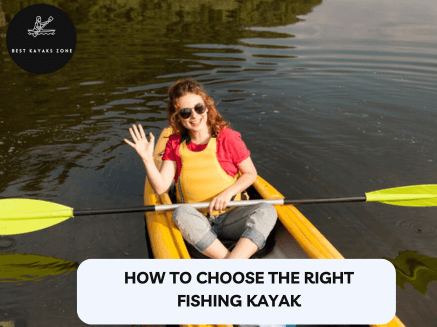
Tessa Young
Kayak Expert

John Smith
![]() Expert Reviewed |Kayak Expert
Expert Reviewed |Kayak Expert
Update
Fishing kayaks have revolutionized the way anglers approach their favorite pastime. These versatile vessels offer unparalleled access to remote fishing spots and provide a unique blend of adventure and relaxation. Whether you are a seasoned fisherman or a novice looking to delve into kayak fishing, choosing the right fishing kayak is crucial.
This guide will navigate you through the myriad of options available, ensuring you make an informed decision.

On This Page
Types of Fishing Kayaks
Sit-on-top Kayaks
Sit-on-top kayaks are immensely popular among anglers for their user-friendly design and stability. These kayaks feature an open deck, allowing for easy entry and exit, making them ideal for warm weather conditions. The self-bailing scupper holes prevent water accumulation, ensuring a dry ride. Their design also facilitates better movement and accessibility to gear, making them a favorite for fishing in calm waters and coastal regions.
Inflatable Kayaks
Inflatable kayaks offer unparalleled portability and storage convenience. Constructed from durable materials, these kayaks are remarkably resilient against punctures and abrasions. They are easy to transport and can be inflated on-site, making them perfect for spontaneous fishing trips. Despite their lightweight nature, inflatable kayaks provide impressive stability and comfort, making them suitable for various water conditions, including rivers and lakes.
Traditional Sit-in Kayaks
Traditional sit-in kayaks offer a more enclosed experience, providing better protection against the elements. These kayaks are designed with a cockpit where the paddler sits inside, offering a lower center of gravity and enhanced stability in rough waters. They are well-suited for colder environments and can be outfitted with spray skirts to keep water out. Sit-in kayaks are ideal for anglers seeking a versatile and weather-resistant option.
Paddle Kayak or Pedal Kayak
Choosing between a paddle and a pedal kayak depends largely on personal preference and fishing style. Paddle kayaks, operated with a double-bladed paddle, are traditional and offer a more hands-on and serene experience. They are generally lighter and more affordable. On the other hand, pedal kayaks are equipped with pedal-driven systems that allow for hands-free operation, making it easier to fish while maneuvering. They offer greater speed and efficiency, especially over longer distances or in windy conditions.
Factors to Consider When Choosing a Fishing Kayak
When choosing a fishing kayak, it’s essential to consider several factors to ensure it meets your specific needs. Here are some key considerations:
1. Stability: A stable kayak is crucial for fishing, especially if you plan to stand while casting. Look for a wider, flat-bottomed kayak for better stability.
2. Comfort: Consider the seat quality, legroom, and overall ergonomics. Adjustable, padded seats and ample space can make long fishing trips more comfortable.
3. Weight and Portability: Think about how easy it will be to transport and store your kayak. Lighter kayaks are easier to carry and load onto vehicles, while heavier models might require a trailer.
4. Length and Width: Longer kayaks track better and are faster, making them ideal for covering long distances. Wider kayaks offer more stability but might be slower.
5. Material: Kayaks are typically made from plastic (polyethylene), fiberglass, or composite materials. Polyethylene is durable and affordable but heavier. Fiberglass and composite kayaks are lighter and faster but more expensive.
6. Storage and Capacity: Consider the amount of gear you’ll need. Look for kayaks with built-in storage compartments, rod holders, and enough weight capacity to carry you and your equipment.
7. Maneuverability: If you’ll be fishing in tight spots or rivers, a shorter, more maneuverable kayak might be best. For open water or long trips, a longer kayak with better tracking may be more suitable.
8. Propulsion: Decide between paddle kayaks, pedal kayaks, or motorized options. Pedal kayaks free up your hands for fishing, while motorized ones require less physical effort.
9. Price: Set a budget considering the features you need. Higher-end kayaks offer better durability, comfort, and advanced features but come at a higher cost.
10. Water Conditions: Consider the type of water you’ll be fishing in—calm lakes, rivers with currents, or ocean waters—and choose a kayak designed for those conditions.
11. Customization Options: Some kayaks come with accessory rails or mounting points for fish finders, GPS, or other fishing gear. This can be a plus if you like to customize your setup.
12. Brand Reputation and Reviews: Research different brands and read reviews to see what other anglers say about their experiences with specific models.
Kayak Features to Look For
Rod Holders
Rod holders are essential for any fishing kayak, providing a secure place to hold your fishing rods when not in use. They free up your hands to paddle, manage your gear, or simply relax. Look for adjustable rod holders that can be positioned for optimal access and efficiency.
Seats
Comfortable seating is crucial for extended fishing trips. High-quality seats with adjustable backrests and ample cushioning can enhance your kayaking experience significantly. Some models even offer elevated seats that provide a better vantage point and improved casting range.
Storage Options
Adequate storage is necessary to keep your gear organized and accessible. Fishing kayaks should have multiple storage compartments, including dry storage for sensitive items and open storage for larger gear. Bungee cords and hatch covers can also help secure your equipment.
Gear Tracks
Gear tracks are versatile mounting systems that allow you to attach various accessories, such as fish finders, GPS units, and camera mounts. They provide customization options to tailor your kayak to your specific fishing needs.
Standing Decks
Standing decks offer a stable platform for casting and sight fishing. A spacious, non-slip deck enables anglers to stand comfortably, enhancing visibility and casting accuracy. This feature is particularly beneficial for fly fishing or in shallow waters where stealth is paramount.
Rudders
Rudders improve maneuverability and tracking, especially in windy or turbulent conditions. They help maintain a straight course with minimal effort, allowing you to focus more on fishing. Look for retractable or adjustable rudder systems for added versatility.
Motor Drive
Motor drives can transform your kayak into a motorized vessel, providing a convenient alternative to paddling or pedaling. They are perfect for covering long distances or fishing in strong currents. Ensure the kayak is compatible with motor mounts and has a battery compartment if you plan to use a motor drive.
Fishing Kayak Dimensions and Shape
Length
The length of a fishing kayak influences its speed, tracking, and maneuverability. Longer kayaks are faster and track better, making them suitable for covering longer distances. Shorter kayaks, however, offer superior maneuverability and are easier to transport and store.
Weight
Consider the weight of the kayak for ease of transport and handling. Lighter kayaks are easier to carry and load onto a vehicle, but heavier kayaks often provide better stability and durability. Balance your need for portability with the kayak’s performance on the water.
Hull Shape
The hull shape affects the kayak’s stability, speed, and handling. A flat hull offers excellent primary stability, making it ideal for calm waters and beginners. V-shaped hulls provide better speed and secondary stability, suitable for rougher conditions and experienced kayakers. Hybrid hulls combine elements of both, offering a versatile performance.
What Length Fishing Kayak is Best?
Choosing the best length for a fishing kayak depends on your fishing style and the water conditions you’ll encounter. For open water and long-distance paddling, a kayak between 12 to 14 feet is optimal. For rivers, creeks, and tighter waterways, a shorter kayak around 10 feet provides better agility and ease of navigation.
Kayak Storage
Proper storage extends the lifespan of your kayak and maintains its performance. Store your kayak in a cool, dry place away from direct sunlight to prevent UV damage. Use a kayak cover to protect it from dust and debris. If possible, store it indoors or use a rack to keep it off the ground and prevent deformation.
Tips for Choosing the Perfect Fishing Kayak
1. Test Before You Buy: Whenever possible, test different kayaks to find the one that feels most comfortable and suits your fishing style.
2. Consider Your Budget: Higher-end models offer more features, but there are quality options available at various price points.
3. Think About Transport: Ensure you have a way to transport your kayak, whether it’s a roof rack, trailer, or pickup truck bed.
4. Research Reviews: Read reviews and seek advice from experienced kayakers to get insights into the pros and cons of different models.
5. Assess Your Needs: Determine what features are most important to you, such as storage capacity, stability, or speed, and prioritize them in your search.
Bottom Line
Selecting the ideal fishing kayak is a blend of personal preference, practical considerations, and an understanding of your fishing environment. By evaluating the types, features, and dimensions of fishing kayaks, you can make a choice that enhances your angling adventures. Embrace the journey of finding your perfect kayak, and may your fishing expeditions be bountiful and exhilarating.
FAQS:
Is it hard to fish from a kayak?
Fishing from a kayak can be challenging, especially if you’re new to kayaking or fishing. However, with practice, most people find it manageable and enjoyable. Kayaks are stable enough for fishing, but balancing and maneuvering while casting or reeling in a catch may take some time to get used to.
Can you fish on any kayak?
You can fish from most kayaks, but some are better suited for it than others. Fishing kayaks are designed with extra stability, storage for gear, and features like rod holders. While you can fish from a regular kayak, a fishing-specific model will make the experience more enjoyable and easier.
What is the best length for a fishing kayak?
The best length for a fishing kayak ranges from 10 to 14 feet. Shorter kayaks (around 10 feet) are easier to maneuver and transport, while longer kayaks (12 to 14 feet) offer better speed and stability, especially in open water. The right length depends on where you plan to fish and your personal preference.
How big of a kayak do I need for fishing?
The size of the kayak you need depends on your weight, gear, and fishing style. A kayak with a capacity that comfortably holds you and your gear is ideal. Generally, a kayak with a weight capacity of 300-400 pounds works well for most anglers.
What is a good-sized kayak for fishing?
A good size for a fishing kayak is around 12 feet in length and 32 inches in width. This size provides a good balance of stability, maneuverability, and storage space, making it suitable for various fishing environments, from calm lakes to rivers and even coastal waters.
What is the difference between a fishing kayak and a regular kayak?
A fishing kayak is designed with features that make it more suitable for fishing, such as increased stability, built-in rod holders, extra storage space, and a more comfortable seating area. Regular kayaks may be faster or lighter, but they lack the specialized features that make fishing easier and more enjoyable.
Does the color of the kayak matter for fishing?
The color of the kayak can matter for fishing, but it’s not a major factor. Some anglers believe that brighter colors like yellow or orange can spook fish less and make the kayak more visible to other boaters. On the other hand, some prefer darker colors for a more stealthy approach. Ultimately, the color choice is more about personal preference and safety.
Is a lighter or heavier kayak better for fishing?
A lighter kayak is easier to transport, carry, and maneuver, which can be beneficial when fishing in different locations. However, a heavier kayak often provides more stability, especially in rough waters. The best choice depends on your fishing environment and how you plan to transport the kayak.
Are sit-on-top or sit-inside kayaks better for fishing?
Sit-on-top kayaks are generally preferred for fishing because they offer better stability, easier access to gear, and the ability to move around more freely. They also tend to be more comfortable for longer periods, especially in warm weather. Sit-inside kayaks can be better in colder conditions, but they are less common for fishing.
About Author

Tessa Young
Kayak Expert
Author information on kayak sites typically includes details about the writers who contribute to the content. This information can vary but commonly includes the author’s name, their background or expertise in kayaking, any relevant certifications or qualifications they may hold (such as kayak instructor certifications or wilderness first aid training), and sometimes a brief bio or personal statement about their experiences with kayaking.
Read More

John Smith
Expert Reviewed | Kayaks Expert
Author information on kayak sites typically includes details about the writers who contribute to the content. This information can vary but commonly includes the author’s name, their background or expertise in kayaking, any relevant certifications or qualifications they may hold (such as kayak instructor certifications or wilderness first aid training), and sometimes a brief bio or personal statement about their experiences with kayaking.
Read More



